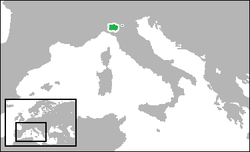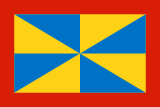- Duchy of Parma
-
Duchy of Parma
Ducato di ParmaState of the Holy Roman Empire ← 
1545–1802
1814–1859 →
→

Flag Coat of arms The Duchy of Parma and Piacenza (green). Capital Parma Language(s) Italian, Emilian Religion Roman Catholic Government Monarchy Duke - 1545–1547 Peter Louis - 1731–1735 Charles I - 1814–1847 Marie Louise - 1854–1859 Robert History - Imperial Diploma September 16, 1545 - Treaty of Aix-la-Chapelle April 24, 1748 - French administration November 1, 1802 - Restauration April 11, 1814 - Italian Unification December 3, 1859 Currency Parman lira The Duchy of Parma was created in 1545 from that part of the Duchy of Milan south of the Po River, as a fief for Pope Paul III's illegitimate son, Pier Luigi Farnese, centered on the city of Parma.
In 1556, the second Duke, Ottavio Farnese, was given the city of Piacenza, becoming thus also Duke of Piacenza, and so the state was thereafter properly known as the Duchy of Parma and Piacenza (Ducato di Parma e Piacenza in Italian).
The Farnese family continued to rule until their extinction in 1731, at which point the duchy was inherited by the young son of the King of Spain, Don Charles, whose mother Elizabeth Farnese was the Farnese heiress. He ruled until the end of the War of the Polish Succession in 1735, when Parma was ceded to Emperor Charles VI in exchange for the Two Sicilies.
The Habsburgs only ruled until the conclusion of the Treaty of Aix-la-Chapelle in 1748, when it was ceded back to the Bourbons in the person of Don Philip, Don Charles's younger brother, which received also the little Duchy of Guastalla. As duke Philip, he became the founder of the House of Bourbon-Parma reigning over the Duchy of Parma, Piacenza and Guastalla (Ducato di Parma, Piacenza e Guastalla in Italian).
In 1796, the duchy was occupied by French troops under Napoleon Bonaparte, and the political situation of the State became extremely confused. Duke Ferdinand maintained his throne under French military governors until the Treaty of Aranjuez of 1801, when a general agreement between the House of Bourbon and Napoleon formally decided the cession of the duchy to France in exchange for Tuscany, but the Duke lasted in Parma until he died in 1802, maybe by poisoning. However, Napoleon was undecided about the future of the duchy, aspiring to a total engagement of the Bourbons in the European wars as his allies. Even if French laws and administration was gradually introduced, the formal annexation to the French Empire was declared only in 1808 after the outbreak of the conflict against Bourbonic Spain. The duchy was reformed as the Département of Taro.
In 1814, the duchies were restored under Napoleon's Habsburg wife, Marie Louise, who was to rule them for her lifetime. After Marie Louise's death in 1847, the Duchy was restored to the Bourbon-Parma line, which had been ruling the tiny Duchy of Lucca. In this context, Guastalla was ceded to Modena. The Bourbons ruled until 1859, when they were driven out by a revolution following the French and Sardinian victory in the war against Austria (called Austrian War in France and Second War of Independence in Italy).
The Duchy of Parma and Piacenza joined with the Grand Duchy of Tuscany and the Duchy of Modena to form the United Provinces of Central Italy in December 1859, and merged with the Kingdom of Sardinia into the Kingdom of Italy in March 1860 after holding a referendum.
The House of Bourbon continues to claim the title of duke of Parma to this day. Prince Carlos of Bourbon-Parma has held the title since 2010.
See also
- County of Guastalla
- Historical states of Italy
- House of Bourbon-Parma
- List of Dukes of Parma
- Pauline Bonaparte
- Pretenders to the throne of Parma
References
- Murphy, Orville Theodore (1982). Charles Gravier, Comte de Vergennes: French diplomacy in the age of revolution, 1719-1787. SUNY Press. ISBN 9780873954822. http://books.google.com/books?id=L8RDnvGrhS4C&pg=PA421. Retrieved 21 February 2011.
Former monarchies of the Italian Peninsula, Sardinia and Sicily Amalfi • Apulia • Arborea • Benevento • Bolzano-Bressanone (Prince-Bishopric) • Byzantine Empire • Cagliari • Capua • Carrara • Castro • Ceva • Corsica • Etruria • Ferrara • Finale • Florence • Gaeta • Gallura • Gorizia • County of Guastalla • Duchy of Guastalla • Illiria • Italy (Lombard) • Italy (Medieval) • Italy (Modern) • Italy (Napoleonic) • Istria • Lombardy-Venetia • Principality of Lucca and Piombino • Lucca • Mantua • Massa • Milan • Mirandola • Modena • Montferrat • Duchy of Naples • Kingdom of Naples • Nizza • Ogliastra • Ostrogothic Kingdom • Papal States • Parma • Piombino • Presidi • Reggio • Roman Kingdom • Roman Empire • Salerno • Saluzzo • Sardinia • Sardinia and Corsica • Savoy • Emirate of Sicily • County of Sicily • Kingdom of Sicily • Sora • Spoleto • Tavolara • Torres • Trento (Prince-Bishopric) • Tuscany • Two Sicilies • Tirolo • Urbino • Verona and Aquileia • Western Roman Empire
Categories:- Former monarchies of Europe
- Former countries on the Italian Peninsula
- States of the Holy Roman Empire
- States and territories established in 1545
- States and territories disestablished in 1859
- 1859 disestablishments
- Dukes of Piacenza
- Parma
- Dukes of Parma
- Contemporary Italian history
- House of Bourbon-Parma
- House of Habsburg
- House of Habsburg-Lorraine
- History of Austria
Wikimedia Foundation. 2010.



